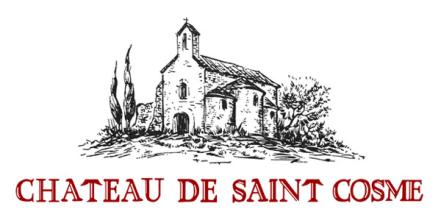Domaine de Saint Cosme Les Deux Albion Blanc
Domaine de Saint Cosme Les Deux Albion Blanc
Château de Saint Cosme is the leading estate of Gigondas and produces the benchmark wines of the appellation. The property has been in the hands of the Barruol family since 1570. Louis Barruol took over from his father in 1992 making a dramatic shift to quality and converting to biodynamics in 2010.
The estate lies in the heart of Gigondas where 15 hectares of vineyard grow in the shade of the Dentelles de Montmirail mountain. In addition to the estate-grown wines labeled “Château de Saint Cosme,” Louis Barruol buys grapes from contracted growers, labeling these “négociant” wines simply as “Saint Cosme.”
Domaine de Saint Cosme Les Deux Albions Blanc carries the Principauté-d'Orange IGP and comes from 10-hectares near Violès, directly across the Ouvèze River from Gigondas. "The level of limestone here is, I think, the highest in the region," says Louis Barruol. This wine is a blend of Viognier and Picpoul vinified in demi-muids and aged on the lees.
Tasting Notes
2016, the inaugural vintage of this wine, is a blend of Viognier and Picpoul and shows the salty minerality typical of limestone terroir with notes of dried apricots and white flowers. The plantings near Violès include Bourboulenc, Marsanne, Viognier, Picpoul, Clairette, and Ugni Blanc, and will be included in future bottlings.
Food Pairing
Viognier aged in neutral barrels has a full body and rich texture with just-medium acidity. It is easily paired with dishes that feature creamy sauces, mild white fish, and roasted pork or chicken. Picpoul brings acidity to the blend and gives this wine salinity, making it a superb choice for cooked or raw shellfish.
Château de Saint Cosme is the leading estate of Gigondas and produces the benchmark wines of the appellation. The property has been in the hands of the Barruol family since 1570. Louis Barruol took over from his father in 1992 making a dramatic shift to quality and converting to biodynamics in 2010.
The estate lies in the heart of Gigondas where 15 hectares of vineyard grow in the shade of the Dentelles de Montmirail mountain. In addition to the estate-grown wines labeled “Château de Saint Cosme,” Louis Barruol buys grapes from contracted growers, labeling these “négociant” wines simply as “Saint Cosme.”
Domaine de Saint Cosme Les Deux Albions Blanc carries the Principauté-d'Orange IGP and comes from 10-hectares near Violès, directly across the Ouvèze River from Gigondas. "The level of limestone here is, I think, the highest in the region," says Louis Barruol. This wine is a blend of Viognier and Picpoul vinified in demi-muids and aged on the lees.
Tasting Notes
2016, the inaugural vintage of this wine, is a blend of Viognier and Picpoul and shows the salty minerality typical of limestone terroir with notes of dried apricots and white flowers. The plantings near Violès include Bourboulenc, Marsanne, Viognier, Picpoul, Clairette, and Ugni Blanc, and will be included in future bottlings.
Food Pairing
Viognier aged in neutral barrels has a full body and rich texture with just-medium acidity. It is easily paired with dishes that feature creamy sauces, mild white fish, and roasted pork or chicken. Picpoul brings acidity to the blend and gives this wine salinity, making it a superb choice for cooked or raw shellfish.














